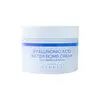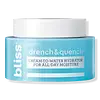What's inside
What's inside
 Key Ingredients
Key Ingredients

 Benefits
Benefits

 Concerns
Concerns

 Ingredients Side-by-side
Ingredients Side-by-side

Water
Skin ConditioningCyclopentasiloxane
EmollientGlycerin
HumectantCyclohexasiloxane
EmollientButylene Glycol
HumectantOctyldodecanol
EmollientSodium Chloride
MaskingCetyl PEG/PPG-10/1 Dimethicone
Emulsifying1,2-Hexanediol
Skin ConditioningPhenoxyethanol
PreservativeSodium Hyaluronate
HumectantDimethicone/Vinyl Dimethicone Crosspolymer
Skin ConditioningParfum
MaskingDisodium EDTA
Borago Officinalis Extract
EmollientCentaurea Cyanus Flower Extract
AstringentChamomilla Recutita Flower Extract
MaskingHyacinthus Orientalis Extract
Skin ConditioningLavandula Angustifolia Flower Extract
CleansingSalvia Sclarea Extract
AntiseborrhoeicEthylhexylglycerin
Skin ConditioningHydroxypropyltrimonium Hyaluronate
Hydrolyzed Hyaluronic Acid
HumectantSodium Acetylated Hyaluronate
HumectantHyaluronic Acid
HumectantHydrolyzed Sodium Hyaluronate
Skin ConditioningSodium Hyaluronate Crosspolymer
HumectantPotassium Hyaluronate
Skin ConditioningWater, Cyclopentasiloxane, Glycerin, Cyclohexasiloxane, Butylene Glycol, Octyldodecanol, Sodium Chloride, Cetyl PEG/PPG-10/1 Dimethicone, 1,2-Hexanediol, Phenoxyethanol, Sodium Hyaluronate, Dimethicone/Vinyl Dimethicone Crosspolymer, Parfum, Disodium EDTA, Borago Officinalis Extract, Centaurea Cyanus Flower Extract, Chamomilla Recutita Flower Extract, Hyacinthus Orientalis Extract, Lavandula Angustifolia Flower Extract, Salvia Sclarea Extract, Ethylhexylglycerin, Hydroxypropyltrimonium Hyaluronate, Hydrolyzed Hyaluronic Acid, Sodium Acetylated Hyaluronate, Hyaluronic Acid, Hydrolyzed Sodium Hyaluronate, Sodium Hyaluronate Crosspolymer, Potassium Hyaluronate
Water
Skin ConditioningCyclopentasiloxane
EmollientGlycerin
HumectantButylene Glycol
HumectantDimethicone
EmollientHydrogenated Polyisobutene
EmollientSodium Acetylated Hyaluronate
HumectantSodium Hyaluronate
HumectantSodium Hyaluronate Crosspolymer
HumectantHyaluronic Acid
HumectantEthylhexylglycerin
Skin ConditioningDimethicone/PEG-10/15 Crosspolymer
Sodium Chloride
MaskingPhenoxyethanol
PreservativeBenzyl Alcohol
PerfumingSodium Citrate
BufferingDimethicone/Vinyl Dimethicone Crosspolymer
Skin ConditioningChamomilla Recutita Flower Extract
MaskingPassiflora Incarnata Seed Oil
Skin ProtectingPotassium Sorbate
PreservativeGuar Hydroxypropyltrimonium Chloride
Skin ConditioningPolysorbate 20
EmulsifyingDipropylene Glycol
HumectantTetrahexyldecyl Ascorbate
AntioxidantTocopheryl Acetate
AntioxidantSilybum Marianum Seed Oil
Skin ConditioningCaprylic/Capric Triglyceride
MaskingPorphyra Umbilicalis Extract
Skin ConditioningTocopherol
AntioxidantCommiphora Mukul Resin Extract
Skin ConditioningSaccharina Longicruris Extract
HumectantRosa Multiflora Fruit Extract
MaskingSodium Benzoate
MaskingLinalool
PerfumingAlpha-Isomethyl Ionone
PerfumingLimonene
PerfumingParfum
MaskingWater, Cyclopentasiloxane, Glycerin, Butylene Glycol, Dimethicone, Hydrogenated Polyisobutene, Sodium Acetylated Hyaluronate, Sodium Hyaluronate, Sodium Hyaluronate Crosspolymer, Hyaluronic Acid, Ethylhexylglycerin, Dimethicone/PEG-10/15 Crosspolymer, Sodium Chloride, Phenoxyethanol, Benzyl Alcohol, Sodium Citrate, Dimethicone/Vinyl Dimethicone Crosspolymer, Chamomilla Recutita Flower Extract, Passiflora Incarnata Seed Oil, Potassium Sorbate, Guar Hydroxypropyltrimonium Chloride, Polysorbate 20, Dipropylene Glycol, Tetrahexyldecyl Ascorbate, Tocopheryl Acetate, Silybum Marianum Seed Oil, Caprylic/Capric Triglyceride, Porphyra Umbilicalis Extract, Tocopherol, Commiphora Mukul Resin Extract, Saccharina Longicruris Extract, Rosa Multiflora Fruit Extract, Sodium Benzoate, Linalool, Alpha-Isomethyl Ionone, Limonene, Parfum
Ingredients Explained
These ingredients are found in both products.
Ingredients higher up in an ingredient list are typically present in a larger amount.
Butylene Glycol (or BG) is used within cosmetic products for a few different reasons:
Overall, Butylene Glycol is a safe and well-rounded ingredient that works well with other ingredients.
Though this ingredient works well with most skin types, some people with sensitive skin may experience a reaction such as allergic rashes, closed comedones, or itchiness.
Learn more about Butylene GlycolChamomilla Recutita Flower Extract comes from the Chamomile flower.
Chamomile is rich in antioxidants and has anti-inflammatory properties. Several compounds found in chamomile help with soothing, such as bisbolol.
Antioxidant components in chamomile make it an effective ingredient to help slow the signs of aging. Antioxidants help fight free-radical molecules, or molecules that may damage your skin.
Essential oils from chamomile have been found to improve wound healing due to its antimicrobial properties.
Ancient Greeks and Egyptians used Chamomile to treat skin redness and dryness. Chamomile has also been used to help treat stomach issues.
Learn more about Chamomilla Recutita Flower ExtractCyclopentasiloxane, or D5, is a silicone used to improve texture of products and trap moisture.
D5 is considered lightweight and volatile. Volatile means it evaporates quickly after application. Once evaporated, D5 leaves a thin barrier that helps keep skin hydrated.
It is also an emollient. Emollients help soften the skin and prevent water loss. Silicones create a silky texture in products. D5 helps other ingredients become more spreadable.
Studies show D5 is safe to use in skincare products. We recommend speaking with a skincare professional if you have concerns.
Learn more about CyclopentasiloxaneThis ingredient is a silicone used to improve the texture of products and absorb oil. It does not get absorbed into the skin.
Like other silicones, Dimethicone/Vinyl Dimethicone Crosspolymer helps condition the skin by creating a barrier. In this sense, it can act as an emollient and trap moisture in.
This ingredient is a type of elastomer.
Learn more about Dimethicone/Vinyl Dimethicone CrosspolymerEthylhexylglycerin (we can't pronounce this either) is commonly used as a preservative and skin softener. It is derived from glyceryl.
You might see Ethylhexylglycerin often paired with other preservatives such as phenoxyethanol. Ethylhexylglycerin has been found to increase the effectiveness of these other preservatives.
Glycerin is already naturally found in your skin. It helps moisturize and protect your skin.
A study from 2016 found glycerin to be more effective as a humectant than AHAs and hyaluronic acid.
As a humectant, it helps the skin stay hydrated by pulling moisture to your skin. The low molecular weight of glycerin allows it to pull moisture into the deeper layers of your skin.
Hydrated skin improves your skin barrier; Your skin barrier helps protect against irritants and bacteria.
Glycerin has also been found to have antimicrobial and antiviral properties. Due to these properties, glycerin is often used in wound and burn treatments.
In cosmetics, glycerin is usually derived from plants such as soybean or palm. However, it can also be sourced from animals, such as tallow or animal fat.
This ingredient is organic, colorless, odorless, and non-toxic.
Glycerin is the name for this ingredient in American English. British English uses Glycerol/Glycerine.
Learn more about GlycerinHyaluronic acid is naturally found in healthy skin. It is a humectant, meaning it draws moisture to your skin.
This ingredient helps hydrate, soothe, and protect the skin.
What makes hyaluronic acid so hydrating? It has the capacity to bind or hold large amounts of water.
Fun fact: It is already naturally found in our bodies, such as the fluids of our eyes and our joints.
Studies find this ingredient to have anti-inflammatory and anti-microbial properties. This can help speed up wound-healing.
Hyaluronic acid can be irritating if the molecule has a low-molecular weight, or if the molecules are small.
One study found low-molecular weight hyaluronic acid to be pro-inflammatory, meaning some people may experience irritation. This is because our bodies use hyaluronic acid in the wound-healing process to signal to our bodies, via irritation, that something needs healing.
The same study found high-molecular weight hyaluronic acid to be anti-inflammatory.
These are some other common types of Hyaluronic Acid:
Learn more about Hyaluronic AcidParfum is a catch-all term for an ingredient or more that is used to give a scent to products.
Also called "fragrance", this ingredient can be a blend of hundreds of chemicals or plant oils. This means every product with "fragrance" or "parfum" in the ingredients list is a different mixture.
For instance, Habanolide is a proprietary trade name for a specific aroma chemical. When used as a fragrance ingredient in cosmetics, most aroma chemicals fall under the broad labeling category of “FRAGRANCE” or “PARFUM” according to EU and US regulations.
The term 'parfum' or 'fragrance' is not regulated in many countries. In many cases, it is up to the brand to define this term.
For instance, many brands choose to label themselves as "fragrance-free" because they are not using synthetic fragrances. However, their products may still contain ingredients such as essential oils that are considered a fragrance by INCI standards.
One example is Calendula flower extract. Calendula is an essential oil that still imparts a scent or 'fragrance'.
Depending on the blend, the ingredients in the mixture can cause allergies and sensitivities on the skin. Some ingredients that are known EU allergens include linalool and citronellol.
Parfum can also be used to mask or cover an unpleasant scent.
The bottom line is: not all fragrances/parfum/ingredients are created equally. If you are worried about fragrances, we recommend taking a closer look at an ingredient. And of course, we always recommend speaking with a professional.
Learn more about ParfumPhenoxyethanol is a preservative that has germicide, antimicrobial, and aromatic properties. Studies show that phenoxyethanol can prevent microbial growth. By itself, it has a scent that is similar to that of a rose.
It's often used in formulations along with Caprylyl Glycol to preserve the shelf life of products.
Sodium Acetylated Hyaluronate is a type of Hyaluronic Acid.
Hyaluronic Acids help moisturize, soothe, and protect the skin.
Read about common types of Hyaluronic Acid here:
Sodium Hyaluronate
Hydrolyzed Hyaluronic Acid
Hyaluronic Acid
Chances are, you eat sodium chloride every day. Sodium Chloride is also known as table salt.
This ingredient has many purposes in skincare: thickener, emulsifier, and exfoliator.
You'll most likely find this ingredient in cleansers where it is used to create a gel-like texture. As an emulsifier, it also prevents ingredients from separating.
There is much debate on whether this ingredient is comedogenic. The short answer - comedogenic ratings don't tell the whole story. Learn more about comegodenic ratings here.
The concensus about this ingredient causing acne seems to be divided. Research is needed to understand if this ingredient does cause acne.
Scrubs may use salt as the primary exfoliating ingredient.
Learn more about Sodium ChlorideSodium Hyaluronate is hyaluronic acid's salt form. It is commonly derived from the sodium salt of hyaluronic acid.
Like hyaluronic acid, it is great at holding water and acts as a humectant. This makes it a great skin hydrating ingredient.
Sodium Hyaluronate is naturally occurring in our bodies and is mostly found in eye fluid and joints.
These are some other common types of Hyaluronic Acid:
Learn more about Sodium HyaluronateSodium Hyaluronate Crosspolymer is a type of hyaluronic acid. In fact, it is modified version of hyaluronic acid.
The structure of Sodium Hyaluronate Crosspolymer allows it to stay in the skin's top layer for a longer period of time. This allows for even more hydration and humectant action than hyaluronic acid.
These are some other common types of Hyaluronic Acid:
Learn more about Sodium Hyaluronate CrosspolymerWater. It's the most common cosmetic ingredient of all. You'll usually see it at the top of ingredient lists, meaning that it makes up the largest part of the product.
So why is it so popular? Water most often acts as a solvent - this means that it helps dissolve other ingredients into the formulation.
You'll also recognize water as that liquid we all need to stay alive. If you see this, drink a glass of water. Stay hydrated!
Learn more about Water